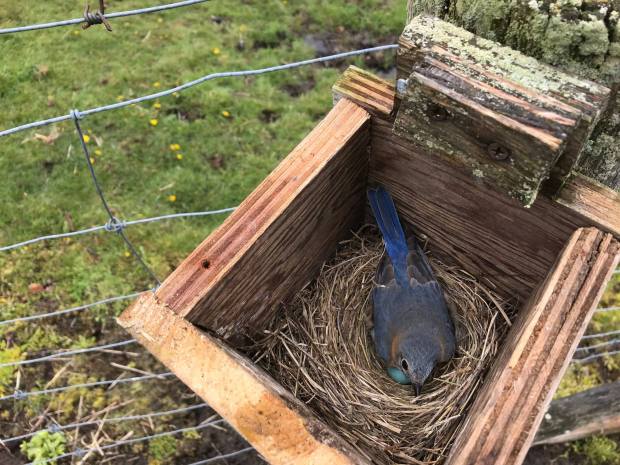Helping Eastern Bluebirds Shelter at Home
Today I’ve invited my brother-in-law, Peter Mordy to write below about a big project he’s been working on over the past four years by building and posting nest boxes in southern Ontario in Canada.

Peter Mordy
A life-long interest of mine has been building, putting up, and monitoring bird nest boxes. I moved to Brighton, Ontario, in January of 2017 and I’m now in my fourth year putting up nest boxes in this rural area.
I spend my winters building the nest boxes over the cold months, put them up in March, and then monitor until the end of summer. To find the best habitat, I look for farms with fenced-in short-grass pasture—cow, horse, sheep, or goat farms are ideal—and I use the fence posts in these areas to support the nest boxes. (I always gain the permission of a farmer before I put any nest boxes on his or her property.)

My nest boxes are designed for Eastern Bluebirds, but I am glad to have any bird or mammal use them. (Though, I am not so keen on insects taking up residence.) To date, my nest boxes have harboured six species of birds: Eastern Bluebird, Tree Swallow, House Wren, House Sparrow, Black-capped Chickadee, and Great-crested Flycatcher. As well, they have held the nests of two species of mammal (Field Mouse and Red Squirrel).
Over the past four years I have put up approximately 220 nest boxes and I plan to continue expanding my nest box empire for the foreseeable future.

Peter Mordy and empire in progress
From time to time I check on the boxes and below are photos to give you an idea of what I find when I’m monitoring.

A typical bluebird nest: blue eggs in a nest made of only grasses, no feathers.

An Eastern Bluebird nest with an unusual clutch of six eggs.

Very pale (albino?) Eastern Bluebird eggs.

Nest box #97, built in 2019.

Four young Eastern Bluebirds about ready to leave their nest box.

House Wren nest.

A Black-capped Chickadee nest, made of mosses, fur, and bark strips. The eggs are white with brown spots.

Black-capped Chickadee at its nest hole.

House Sparrow nest.

This bluebird nest contains two Brown-headed Cowbird eggs.

A bluebird incubating its eggs.

A typical Tree Swallow nest, made of grasses with many feathers. The eggs are white.

A Tree Swallow on its nest. The nest is actually behind the bird, where all the feathers are.

A young bluebird that will soon be ready to leave its nest.

Why, hello there! A field mouse looks out from its nest in a nest box.

A House Wren nest that has been built similar to how a Winter Wren would construct its nest, with a small entrance to the nest inside the twig jumble.

A typical House Wren nest, with an open top to the nest (unlike the previous picture). The eggs are brown. Nest is made of twigs and lined with feathers and grass.

A Savannah Sparrow nest, found in a farm field. (Nothing to do with bird houses.)

A bluebird nest built on the twigs of a wren’s dummy nest.

A Great-crested Flycatcher nest, built in a nest box that had had its entrance hole greatly enlarged by a squirrel. The six eggs are marbled brown on a brown base.

As long as there are Eastern Bluebirds I will build boxes for them.

I’m glad you’re doing this project, Peter. The photos are great to see, too!
LikeLiked by 1 person
Amazing dedication, and great photos! Thanks for sharing this!
LikeLike
This was a lovely blogg post
LikeLiked by 1 person